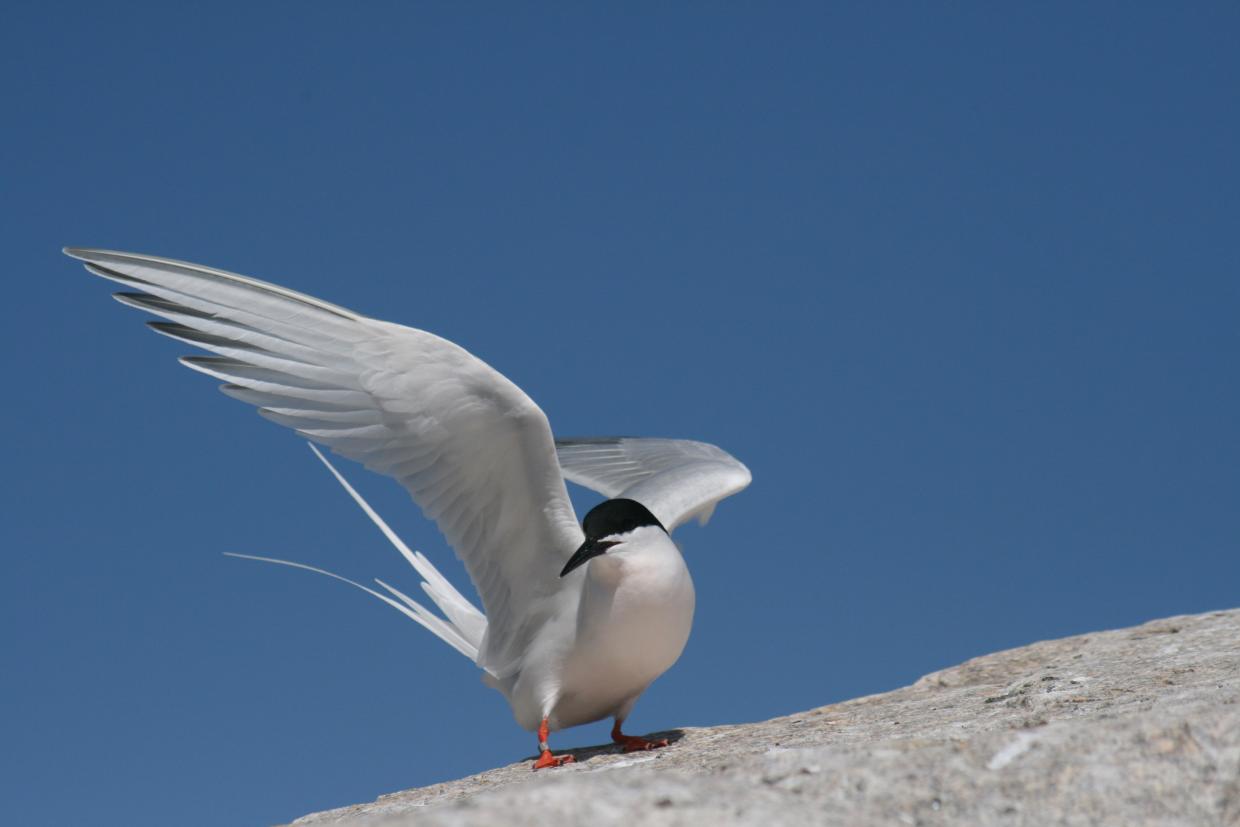Fast facts
Common name: Roseate tern
Scientific name: Sterna dougallii
Size: 13–16 inches in length, 3.2–5 ounces in weight, wingspan roughly 30 inches
Range: Scattered breeding distribution in tropic and subtropic Atlantic, Indian, and Pacific Oceans
Conservation status: Endangered in MA and federally
Fun fact: Calls include high-pitched chi-vik for advertising, and musical kliu and raspy aaach for alarming others
Description
Breeding adults have pale gray backsides and white undersides that flush with pale pink in the early breeding season. The tail is mostly white and deeply forked with two long outer streamers that extend well past tips of folded wings. The head is capped in black and the bills are black, which become more red at the base as the season progresses. The legs and feet are orange.
Non-breeding adults have white heads with black markings that merge with black patches that extend from the eyes back to the nape. Juveniles have buff or pale gray backsides barred with a black chevron pattern. The heads are mottled with black patches extending from the eyes back to the nape. Juvenile legs and bills are black. Hatchlings have distinctive grizzled buff and black or gray and black down that looks spiky.
Similar species: Common terns (Sterna hirundo) are similar in size, are darker in color, and have shorter tails. Arctic terns (Sterna paradisaea) are also similar in size, have shorter, blood-red bills, very short red legs, and shorter tails. Least terns (Sternula antillarum) are smaller than roseate terns, have yellow-orange bills, white heads, and a shorter tail.
Population status
In 2000, there were over 4,310 nesting pairs of roseate terns. The population declined to 3,320 nesting pairs in 2006. Roseate terns are listed as endangered on both the Massachusetts and Federal Endangered Species Lists.
Conservation
Roseate terns were sought after for their feathers in the 1800s. By the 1880s, the northeast breeding population had only 2,000 nesting pairs. The population rose and fell over time with a high of 8,500 pairs in 1930 to the most recent count of 3,320 pairs in 2006.
Roseate tern colonies are protected by posted signs, wardens, and exclusion fences. Wooden nest boxes and protectors enhance the number of potential nest sites in breeding locations. Plant density in nesting areas is controlled as to not impede access to nesting sites.
MassWildlife is part of the Roseate Tern Recovery Team. Each spring, staff and volunteers clear nuisance plants and install nest protector boards. Throughout the summer, they monitor nests and band chicks until the roseate terns migrate to wintering grounds. Staff use this information better learn about these protected birds.
Habitat
In Massachusetts, roseate terns commonly nest on sandy, gravelly, or rocky islands. Less commonly, small groups will nest at the end of barrier beaches. Nest sites are typically in dense vegetation—such as seaside goldenrod and beach pea—for protection and cover by chicks. Large boulders are used for cover at other locations in the northeast.
Life history
Adults live for approximately 10 years. The oldest known roseate tern lived to 25 years.
Most roseate terns begin to breed at 3 years of age, while some wait until at least 4 years. Roseate terns arrive to Massachusetts nesting areas between late-April and the first week of May. Eggs are laid between mid-May and mid-August. Incubation lasts for 3 weeks, then nestling lasts for 4 weeks. Pairs only brood once per season, but will renest if they lose eggs or chicks. Adult pairs are protective and actively defend their nests.
Roseate terns are gregarious. The largest colony in Massachusetts has about 1,100 pairs. In the northeast portion of their range, roseate terns nest with common terns, forming clusters or sub-colonies within larger common tern colonies.
Roseate terns almost exclusively feed on small fish. They mainly capture food by plunge diving—diving from heights of 3–40 feet and often submerging to over 20 inches under the water's surface. Roseate terns mainly eat sandlance, but they will occasionally eat crustaceans. Other prey items in Massachusetts waters include herrings, bluefish, Atlantic mackerel, Atlantic silverside, and anchovies.
More information
Learn more about roseate terns with our fact sheet.
Get an overview of the Massachusetts Endangered Species Act.
Contact
Online
Phone
Open M–F, 8 a.m.–4 p.m. (closed noon–12:30 for lunch)
